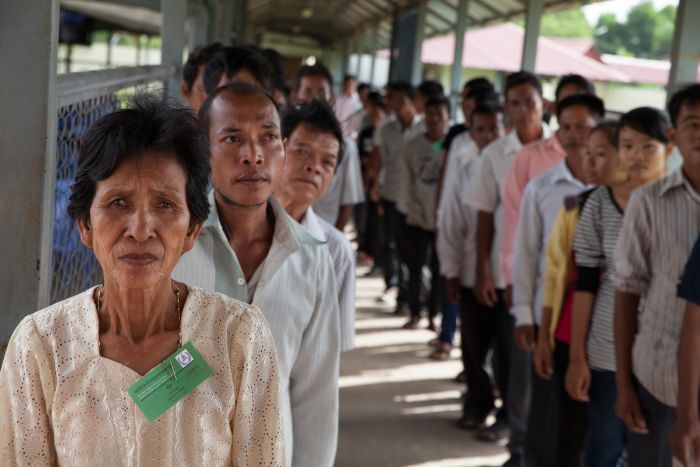Table of Contents
- Foreword by the Co-Chairs
- Letter from the Convening Organizations
- Executive Summary
- Defining the Challenge
- Chapter 1: Leadership
- Chapter 2: Early Warning
- Chapter 3: Early Prevention
- Chapter 4: Preventive Diplomacy
- Chapter 5 Employing Military Options
- Chapter 6: International Action
- Summary of Recommendations
- Appendices
- View and Download Full Report
Preventing Genocide: A Blueprint for U.S. Policymakers
We have the privilege of leading three organizations that share a commitment to enhancing America's role in promoting peace and preventing genocide and mass atrocities.
The idea for the Genocide Prevention Task Force arose out of a desire by each of our institutions to reach beyond our individual capabilities and build a practical framework that could help the U.S. government better respond to threats of genocide and mass atrocities. We fully recognize the enormity of this challenge and the ambitious scope of the recommendations in this report, and we hope we have made a meaningful contribution toward this end.
We are deeply grateful to the co-chairs of this task force: former U.S. secretary of state Madeleine K. Albright and former U.S. secretary of defense William S. Cohen. Their leadership and investment of time and energy in this project have resulted in a report that, if implemented, can positively enhance the U.S. government's ability to prevent future genocides and mass atrocities. The selection of the membership of the task force was a collective enterprise between the convening organizations and the co-chairs, leading to the creation of a strong panel of American leaders.
We thank the individual task force members, whose wide range of talent and expertise strengthened our deliberations and final product. The task force included former government officials from both parties and from several administrations. It comprised people with international, diplomatic, military, humanitarian, and other relevant experience: John Danforth, Thomas Daschle, Stuart Eizenstat, Michael Gerson, Dan Glickman, Jack Kemp, Gabrielle Kirk McDonald, Thomas R. Pickering, Vin Weber, and Anthony Zinni. Julia Taft was an active member until her untimely death in March 2008.
The task force was guided and informed by the work of our expert group leaders-Lawrence Woocher and J Alexander Thier of the United States Institute of Peace, Paul Stares of the Council on Foreign Relations, Victoria Holt of the Henry L. Stimson Center, and Tod Lindberg of Stanford University's Hoover Institution-and the members of their working groups and project staff. The work of the five expert groups covered the comprehensive set of actions required for effective genocide prevention and response: (1) assessing risks and providing warning of potential atrocities; (2) pre-crisis engagement in countries at risk; (3) halting and reversing escalation toward mass violence; (4) military options to prevent and stop ongoing atrocities; and (5) shaping the international system to prevent genocide.
The Genocide Prevention Task Force was officially launched on November 13, 2007 at the National Press Club in Washington. The task force held three formal plenary meetings (in December 2007, May 2008, and September 2008) as well as numerous consultations and informal exchanges. Our expert groups consisted of some fifty individuals from nongovernmental organizations and academia as well as former government officials across the political spectrum. Each group explored the critical objectives and major challenges in its domain, the readiness of the U.S. government to achieve these objectives and meet these challenges, and the institutional and strategic changes that would enhance U.S. government preparedness. Their discussions generated scores of insights and good ideas.
Our special thanks go to the executive committee of the task force: Brandon Grove, executive director (The American Academy of Diplomacy, or AAD); Ann-Louise Colgan, project manager; John Heffernan (United States Holocaust Memorial Museum, or USHMM); and Abiodun Williams and Lawrence Woocher (United States Institute of Peace, or USIP), as well as Tara Sonenshine, strategic advisor to the task force. We would also like to thank USHMM's Committee on Conscience for all their support.
We acknowledge with appreciation the support of the leadership of the three convening organizations: at USHMM, Fred S. Zeidman, chairman, Joel M. Geiderman, vice chairman, and Tom A. Bernstein, chairman, Committee on Conscience; at AAD, Thomas R. Pickering, chairman, Marc Grossman, vice chairman; and at USIP, J. Robinson West, chair, and George E. Moose, vice chair.
Finally, we would like to recognize with gratitude the support of Humanity United, the lead funder of this project, as well as the Sudikoff Family Foundation.
Sara J. Bloomfield, Director, United States Holocaust Memorial Museum
Ronald E. Neumann, President, The American Academy of Diplomacy
Richard H. Solomon, President, United States Institute of Peace

